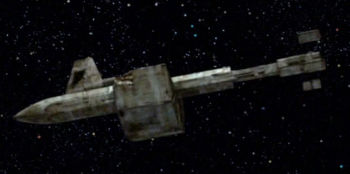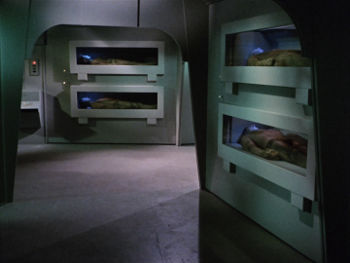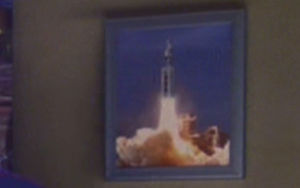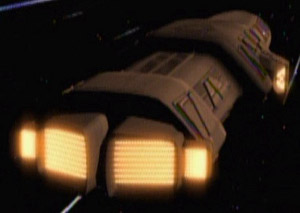DY-100 class

DY-100 class (TOS-24)

DY-100 class interior (TOS-24)

DY-100 class liftoff (ENT-50)
A late 20th century interplanetary vessel design built on Earth using nuclear-powered engines and equipped with suspended-animation chambers for longer voyages during the pre-warp era, superceded in 2018 by designs with better sublight technology. The Botany Bay, launched in 1996, was a DY-100 class ship.[1] In 1996, Rain Robinson had a photograph of a DY-100 class ship lifting off on display in her office;[2] this same image was on display in the 602 Club in San Francisco in the mid-22nd century.[3]
References
- 1. “Space Seed.” Star Trek, Episode 24. Television. 16 February 1967.
- 2. “Future’s End, Part I.” Star Trek: Voyager, Episode 150. Television. 6 November 1996.
- 3. “First Flight.” Star Trek: Enterprise, Episode 50. Television. 14 May 2003.
Dreadnought

Dreadnought (VOY-134)
Maquis designation for the Cardassian ATR-4107 tactical missile that was launched in 2370. The weapon carried a charge of 1000 kilograms of matter and an equal amount of antimatter, enough explosive power to destroy a small moon. Dreadnought was controlled by a sophisticated computer system that was highly adaptable, capable of evasion, and equipped with advanced defensive weaponry. Dreadnought was originally programmed to destroy a Maquis munitions base on the planetoid Alpha 441 in the Badlands, but failed to detonate at its target and was subsequently captured by Maquis member B’Elanna Torres, who reprogrammed it to destroy a Cardassian fuel depot on planet Aschelan V. One day after Dreadnought was launched toward Aschelon V, it was captured by the Caretaker and brought to the Delta Quadrant. In this unfamiliar environment, Dreadnought’s control computer locked onto planet Rakosa V, threatening Rakosa’s two million inhabitants. Torres, who at that point was aboard the U.S.S. Voyager NCC-74656, intercepted Dreadnought in early 2372 and was successful in destroying it before it could reach Rakosa V.[1]
References
Dierdre
The freighter Dierdre supposedly sent a distress call to the U.S.S. Enterprise NCC-1701 on Stardate 3497.2. The signal was a hoax sent by a Klingon vessel, and was the second Klingon attempt to prevent the Enterprise from returning to the planet Capella IV. Upon receipt of the fraudulent message, Chief Engineer Scott, who was temporarily in command of the Enterprise at the time, succinctly commented, “Fool me once, shame on you. Fool me twice, shame on me.”[1]
References
U.S.S. Destiny

Sovereign class (ST-08)
In late 2374, shortly after the death of Jadzia Dax,[1] the Sovereign class[4] Destiny, under the command of Captian Raymer, was assigned to transport the ailing Dax symbiont from Deep Space 9 back to Trill.[1] Along the way, Dax took a turn for the worse. Ensign Ezri Tigan was the only Trill aboard the vessel, and became the new Ezri Dax.[2] The Destiny returned to Deep Space Nine in early 2375 before joining the Seventh Fleet at Kalandra. Dax was to have rejoined the ship’s crew but she opted instead to accept a posting at Deep Space 9.[3]
References
- 1. “Tears of the Prophets.” Star Trek: Deep Space Nine, Episode 550. Television. 15 June 1998.
- 2. Image in the Sand.” Star Trek: Deep Space Nine, Episode 551. Television. 28 September 1998.
- 3. “Afterimage.” Star Trek: Deep Space Nine, Episode 553. Television. 12 October 1998.
- 4. Star Trek: Armada. Game. Activision. 2000.
Death Rite class

Death Rite class (FASA-2301)
| Specifications | Original | Refit |
|---|---|---|
| Length | 160 meters[1] | 160 meters[1] |
| Width | 110 meters[1] | 110 meters[1] |
| Height | 22 meters[1] | 24 meters[1] |
| Mass | 85,400 metric tons[1] | 95,600 metric tons[1] |
| Crew | 330[1] | 340[1] |
| Troops | 180[1] | 200[1] |
| Shuttlecraft | 4[1] | 4[1] |
| Cruising Speed | Warp 7[1] | Warp 8[1] |
| Emergency Speed | Warp 8[1] | Warp 9[1] |
| Weapons | 6 KD-5 disruptors[1] | 6 KD-8 disruptors[1] |
The Death Rite class cruiser, known as the D-20 to Starfleet, was commissioned in mid-2254 and immediately rushed into the Four Years War, where they were used much like the famed D-7. Though the class suffered from a lack of maneuvering power and a relatively weak superstructure, it seemed to make up for these deficiencies in its weapons and shielding. This fault was corrected in 2270; the refit model was far more maneuverable and had more power, as well as a more efficient shielding system and a stronger superstructure. The class was produced at Gnuu Re’ and H’rez. The class was named from “the death of honor,” a traditional death rite; in this rite, a captive who has fought well was killed with a silver dagger handed down through family lines. When a family line was broken, the dagger was destroyed after it was used to eliminate the last family member.[1]
References
Dath D’lan class

Dath D’lan class (FASA-2301)
| Specifications | |
|---|---|
| Length | 234 meters[1] |
| Width | 128 meters[1] |
| Height | 34 meters[1] 45 meters (refit)[1] |
| Mass | 79,900 metric tons[1] 85,000 metric tons (refit)[1] |
| Crew | 218[1] 225 (refit)[1] |
| Passengers | 220[1] |
| Shuttlecraft | 2[1] |
| Cruising Speed | Warp 7[1] Warp 8 (refit)[1] |
| Emergency Speed | Warp 8[1] Warp 9 (refit)[1] |
| Weapons | 2 KD-4 disruptors[1] 2 KD-5 disruptors; 1 KD-10 disruptor; 2 torpedo tubes (refit)[1] |
The Dath D’lan class destroyer, known to Starfleet as the D-11, was the most unusual design in the Klingon fleet, easily recognized on visual scan because of its single wing, and was commissioned in mid-2262. That the vessel never fared well in battle was blamed on its asymmetrical design, which worked to restrict the field of fire from the weapons mounting hardpoints. Able to travel at speeds of Warp 7, it was one of the fastest ships in known space at the time it was commissioned, as well as having had satisfactory tactical maneuverability. Nevertheless, the class was unpopular, as it lacked sufficient firepower to perform its duties. It’s unsurprising that a refit was commissioned in 2270 to upgrade the weapons systems, extending their range by 80,000 km, but battle performance was not significantly improved.[1]
› Continue reading
D’esta Kar class

D’esta kar class (FASA-2301)
| Specifications | Original | Refit |
|---|---|---|
| Length | 220 meters[1] | 220 meters[1] |
| Width | 170 meters[1] | 170 meters[1] |
| Height | 42 meters[1] | 42 meters[1] |
| Mass | 59,800 metric tons[1] | 60,100 metric tons[1] |
| Crew | 285[1] | 292[1] |
| Passengers | 30[1] | 30[1] |
| Shuttlecraft | 2[1] | 2[1] |
| Cruising Speed | Warp 6[1] | Warp 6[1] |
| Emergency Speed | Warp 7[1] | Warp 7[1] |
| Weapons | 4 KD-6 disruptors; 2 torpedo launchers[1] | 4 KD-6 disruptors; 2 torpedo launchers[1] |
The D’esta Kar class, known as the D-14 to Starfleet, was introduced in 2274; in 2278, it was modified to add a cloaking device and an additional transporter. The class name referred to a predator on the planet Nogunda, which immobilized its prey by injecting a paralyzing agent through its stinger.[1]
References
D’ama class

D’ama class (FASA-2301)
The D-4—which was the predecessor of the famed D-7 and was known to its Klingon builders as the D’ama, or “predator,” class—pioneered the command-pod design that would later become the standard for most Klingon warships in the late 22nd and 23rd centuries. The class was introduced in 2142 with the commissioning of eight ships, and was produced at the alarming rate of one per month at facilities operating as if under wartime production orders. It wasn’t until Operation Dixie in the 2280s that it was discovered that the Klingons were, in fact, being attacked by an unknown enemy. During this conflict, the D’ama class saw extensive action and went through several different modifications, most of which were never brought into active production. The conflict ended about two years later, slowing further development.[1] The Klingon Ship Recognition Manual indicates its production date was 2242, but given the appearance of a similar design in the Star Trek: Enterprise episode “Unexpected”, and the appearance of the D-5 class later in the series, 2142 is a more likely date.
References
D’aka class

D’aka class (FASA-2301)
The D’aka class assault ship, known to Starfleet as the T-3 class, was in production from 2248 to 2281. Of the 480 that were built, in 2281, 286 remained in service, 24 were in reserve fleets, 112 had been destroyed, 5 had been scrapped, and 53 had been sold to the civil sector. The class name came from a word which meant “mover.”[1]
References
D-7 class

D-7 class (DS9-503)
The D-7 was probably the most infamous cruiser ever to stalk the spacelanes. These ships were associated with death and destruction on a scale second to none. When first introduced in late 2244, these vessels captured the minds and spirits of the Klingon commanders so fully that for many years they were viewed by outsiders as the symbol of Klingon tyrrany. This design was developed from the earlier d’ama (D-4) class cruiser and incorporated all of its most popular features. The command pod mounted forward on the boom assembly and the wing-like main hull were altered slightly, but all of the basic concepts were retained.[4]
› Continue reading
Categories
- Animated Series (60)
- Articles (28)
- Books (447)
- Cast & Crew (79)
- Comics (22)
- DS9 (328)
- Early Voyages (125)
- Education (5)
- Enterprise (373)
- Excelsior (36)
- Food (19)
- Games (223)
- Klingon (70)
- Library (1,543)
- Logs (593)
- Lost Era (55)
- Medicine (18)
- Merrimac (1)
- Mirror (35)
- Miscellaneous (13)
- New Frontier (54)
- Next Generation (635)
- Original Series (681)
- Personnel (436)
- Places (369)
- Politics (12)
- Recreation (10)
- SCE (41)
- Science (1)
- Shatnerverse (9)
- Ships (455)
- Site Updates (98)
- Starfleet Academy (86)
- Stargazer (42)
- STO (61)
- Technology (45)
- Titan (59)
- To Boldly Go (1)
- TV/Film (214)
- Uncategorized (4)
- Vanguard (76)
- Voyager (236)
- Weapons (27)
- Xenology (54)